January 2012
Roadside Attractions
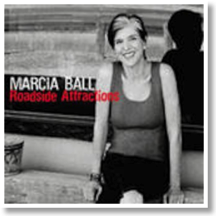
Roadside Attractions
Alligator Records
Marcia Ball exemplifies the tradition of blues sass and confidence: “Lookout Mountain is a molehill/The Grand Canyon’s just a big old crack/Old faithful is fickle/Niagara Falls’ a trickle/The Taj Mahal is nothing but a shack/They got the London Bridge/The Pyramids…I’m coming home.” With vocal, piano, guitar, bass, drums, and the Hammond B3 organ, the title track offers the listener an overview of her highly regarded fervent swamp blues sound and her four decades-long performance career on the blues touring circuit. And the theme is clear: her blues passion remains intact. “I’m still your girl,” she declares. Alligator Records, which at one time or another had artists such as Koko Taylor, Lonnie Brooks, and Charlie Musselwhite on its roster, once again benefits from a wise decision with an outing where Marcia Ball’s thoughtful lyricism penetrates every number and her sincere vocals and talented piano-playing wonderfully complement the subject at hand.
Aside from an autobiography of love, tales, and merriment, the blues sound expands to include country music underpinnings (“Between Here And Kingdom Come”), soul music influences (the up-tempo and cautionary “Look Before You Leap”) spirited jazz (“We Fell Hard,” featuring prominent saxophones and trumpets), and Cajun & zydeco (“This Used To Be Paradise”). The rolling “Everybody’s Looking For the Same Thing” and storm of “Sugar Boogie” recall the rollicking piano thumps and boogie-woogie cadences of Professor Longhair, Champion Jack Dupree, Fats Domino, and Huey “Piano” Smith. The few steady takes such as the blues-burnt “I Heard It All,” a mix of heartbreak and sorrow in an “I Heard It Through the Grapevine” setting, display Ball’s ability to handle ballads as well as kinetic numbers.
After forty years of performing blues music and countless musical plaudits in tow, Marcia Ball’s Roadside Attractions is a personal and creative watershed all in one. She leaves her fans with a fitting ending in the festive romp “The Party’s Still Going On,” signaling the endurance of her Louisiana blues musical muscle.
by Jeff Boyce
Bring It On
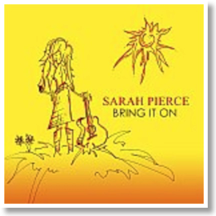
Bring It On
Little Bear Records
On the album cover to her eighth full-length release, a drawing of Sarah Pierce stands with guitar in hand, content, the sun creating a vibrant yellow background. It seeps into the back cover, where a photo shows her in a sunflower-print dress. Even before listening to the album’s first seconds, one can envisage a song list full of felicity, wisdom, and warmth. The opening “Bring It On” sews all of these elements together, connecting a breezy guitar and sunny vocals to an inspirational belief to “live my life loud and proud” and experience new trails in a relationship no matter if “some people say my head’s in the clouds.” The repetition of “bring it on” serves as a catalyst for the remainder of the album where love, courage and tenacity are preponderant.
Mountain dulcimer, mandolin, dobro, fiddle, accordion, drums, and Wurlitzer electric piano are some of the instruments that enliven the folk flourishes, rock-pop, and light country terrain. Pierce’s voice sounds like a cross between Natalie Merchant, Shawn Colvin, and Stevie Nicks, although it roughens on the dark tragedy of “Pearl Handled .44.” With “Pearl,” Pierce performs spoken interludes above a languid backdrop, recounting the tale of a heroine who is shot by her lawman lover on accident. Another number, “I Like a Man,” is dressed with a slow gait with Hammond B3 organ and bluesy guitar licks, recalling the Southern soul music ballads of the 1960s. With these exceptions, the sunny disposition of Bring It On reigns dominant. “Love Being In Love,” “Butterfly Tattoo,” “Twenty Dollar Silver Plated Ring,” and “Our Love’s a Little Crazy” are upbeat affairs, while a theme of female strength and endurance informs “Wild And Gnarly Ride” and “Cowgirls Ride.” The latter has a pronounced country theme and mentions celebrated pop-country chanteuse Patsy Cline.
While Bring It On may touch on overused imagery at times, it does hold up through Pierce’s vocals and lyrical relation to the album’s generally bright vibe on relationships and self-love. And although the album has a strong country music propensity, it has touches of blues music and noticeable folk and rock-pop leanings to broaden the stylistic palette. As Pierce has indicated: “I truly respect and love all styles of music.”
by Jeff Boyce
Acrobats
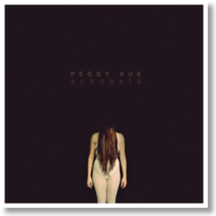
Acrobats
Yep Roc Records
This is the second album from indie-alternative British trio Peggy Sue and the first with an electric guitar tilt, reaping from Rosa (Rex) Slade’s, Olly Joyce’s, and Katy (Klaw) Young’s beloved indie/alternative acts of their youth which include Sonic Youth, P J Harvey, and The Breeders. The little-over-six-minutes “Cut My Teeth” is a gelling of these combined influences, with its raw P J Harvey-esque vocals and love-wrecked lyricism, rolling rhythm of the Breeders (especially starting at 4:12), and crunching electric guitars reminiscent of Sonic Youth, serving as the guidepost to what follows.
Whether it’s the energetic numbers, from the intensity-building “There Always Was,” with its dual vocals and militaristic drums, to the hypnotic bluesy love of “All We’ll Keep,” and the slower grooves of glockenspiel-steady “Parking Meter Blues” and folk-framed “Shadows,” Acrobats effectively displays the difficulty in maintaining great focus, agility, and balance with affectionate relationships while reaching back into the alternative rock sounds of the early 1990s.
by Jeff Boyce
Geckos In The Elevator
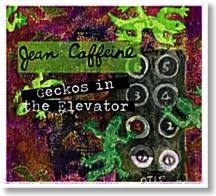
Geckos In The Elevator
Joe Records
Her name rolls off your tongue easily: Jean Caffeine. The album title piques one’s curiosity. Drawings of geckos, some traditional-looking or with an Asian aesthetic, appear on the outside. And then a guitar stab; “Lucky Penny” is introduced, carried throughout with a steady backbeat and a Patti Smith-esque vocal. Coming from the nascent American punk scene of the 1970s and playing with The Clash and PiL, Caffeine filters these early musical experiences through a pot of rock, folk, and alternative country flavors she gathered along her musical exploration.
The musings of “Love Letters from Laos” hints at the Asian inspirations through Caffeine’s travels, where she earned fans in the Indochina region, from Thailand to Vietnam. The abstract Celtic folk of “Mary O’Shea” has a Bob Dylan slant, and “Jane Rearranged” reflects on self-evaluation during her tenure in New York. The gorgeous “Baby I’m Wrong” has a nice arrangement with soothing vocals counterpointing lackadaisical ones, and “Hey Austin” highlights the Austin, Texas, nightlife scene. Accordion and calliope contribute to “Sadie Saturday Nite,” which reaches into the recesses of unadorned folk music, yet the lyrics capture the story of a young girl’s exposure to the early San Francisco punk scene.
So back to the geckos and the elevator; the gecko symbolizes luck and renewal, and an elevator’s rise is concurrent with a rise in status and a rise above a storm, and these qualities blanket the album. But even if one fails to see the connection of why anyone would put geckos in an elevator, the veteran Townes Van Zandt did rave: “I don’t care what anyone else thinks. I’m a fan!”
by Jeff Boyce
Dreams Come True
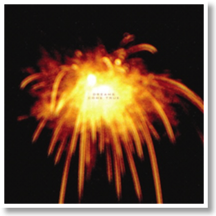
Dreams Come True
Terrible Records
Rock music generally goes through cycles and trends as generations who grew up listening to their favorite artists go back and try to imitate or incorporate those sounds in their own work. One classic example is the way ’50s rock and roll experienced a great resurgence in the 1970s. For the new millennium, the ‘80s has dominated many facets of rock and pop music, with its electronic effects and New Wave and post-punk energy.
Dreams Come True, Chris Taylor of Grizzly Bear’s initial solo album as CANT, is washed in electronic beats and a dreamy haze. The brief classical instrumental “(brokencollar)” shifts from this hard-hitting and experimental style, creating a jarring and puzzling listen. Compare this to the haunting machinations of “Dreams Come True,” in the mode of Nine Inch Nails. While it is the most assaulting track on the album, it does follow the other material in execution. The vocal mixing to the gloomy “Bericht” sounds under-produced and would have fit better if it had followed directly after “(brokencollar).”
But the album does have an upside in its multi-layered instrumentation and ambitious elocution of ping-ponging beats, delay, echo, and varying sinister and somber auras. One might term it “controlled electronic cacophony,” strengthened by the album title; others might call it “misguided electronic noise.” For a particular high point of the album, “Too Late, Too Far” will hook you in with its slamming electronics and entrancing effects.
by Jeff Boyce


